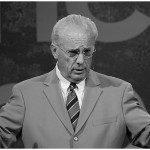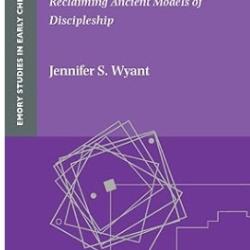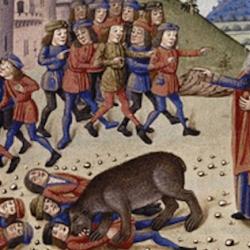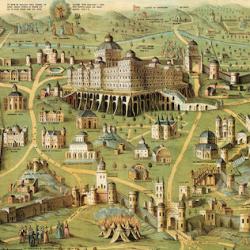Here’s another lecture outline, largely based on recent work I’ve done in Kings.
INTRODUCTION
As I like to tell my theology students, the movie Shrek is a goldmine of hermeneutical insight. Nearly every joke in the movie depends on the viewer knowing something that is not presented in the movie itself. If you don?t know fairy tales, pop culture, pop music, and other films, you miss most of the humor.
All texts function this way, because no author does or could provide all the relevant information to interpret the text. At the very least, he assumes that the reader knows the meanings of words, and usually he assumes that the reader knows a lot more than that. Good interpretation means knowing what relevant information from outside the text should be brought in to shed light on what?s inside the text. Being a good biblical interpreter is like having a good sense of humor.
This is not arbitrary: Every text gives clues to what outside information is relevant, and good interpretation involves noticing and grasping the significance of those clues. Shrek assumes an ideal audience of people immersed in pop culture and fairy tales, and getting the joke requires the reader to pick up on the hints, cues, and clues that the writers leave. At the same time, there may be relevant, even crucial, information that the author did not hint at or think of when he wrote the text. Marx had no knowledge of the Gulag, but can we read The Communist Manifesto without bringing Solzhenitsyn?s work into our interpretation? Should we?
Skeptics about typology often object, ?That?s not in the text. You brought that in from outside.?E To which the proper response is, ?Of course. How else does one read??E
COUNTERFEIT DAVID
To illustrate: Scripture tells us little about Omri, the founder of the greatest dynasty of the Northern Kingdom. But what it tells us is significant. Nearly every detail parallels the life of David.
-The king before Omri is Zimri. Zimri?s reign lasts only a week, and he dies by setting fire to the king?s house in Tirzah and letting it burn down over him (1 Kings 16:18). This reminds us of Saul?s suicide (1 Samuel 31:3-4).
-Prior to becoming king, Omri serves as ?commander of the host?E(1 Kings 16:16), a position similar to David?s under Saul (1 Samuel 18:13).
-As commander, Omri fights Philistines (1 Kings 16:15-16). David makes his reputation as a warrior by fighting the Philistine giant Goliath and by killing his ?ten thousands?Eof Philistines (1 Samuel 17; 18:6-7, 20-30).
-After Zimri?s death, Omri fights a civil war against Tibni ben-Gineath and Omri eventually prevails (1 Kings 16:21-22). This is like ?long war?Ebetween David and Ish-bosheth of the house of Saul (2 Sam. 3:1).
-Both David and Omri have two capitals during their reigns. After defeating Ish-bosheth, David remains in Hebron for seven-and-a-half years (2 Samuel 5:5) before conquering Jerusalem and making it his capital (2 Sam. 5:6-16). After conquering Tibni, Omri retains the capital at Tirzah for six years (1 Kgs 16:23) before purchasing Samaria (v. 24).
-David conquers his capital, while Omri buys his. But Omri?s purchase of the hill of Shemer is like David?s purchase of the threshing floor of Araunah in Jerusalem (2 Samuel 24:18-25).
Omri promotes idolatry in the Northern kingdom, something David never did (16:25). He is like David, but basically unlike David. He is a counterfeit David, and his dynasty is a counterfeit Davidic dynasty. We can?t grasp what the writer of Kings is saying about Omri without bringing the life of David into play.
END OF THE OMRIDES
Curiously, the end of the Omride dynasty is similar to the end of the Southern kingdom of Judah. Jehu, who destroys the Omrides, moves from the destruction of a royal house to the destruction of a house of worship, the house of Baal in Jerusalem (2 Kings 10:18-36). Likewise, 2 Kings 25 says that the Chaldeans slaughter the sons of Zedekiah and take him into exile (vv. 1-7), and then describes the destruction of the house of Yahweh in Jerusalem (vv. 8-17).
Moreover, following Jehu, there is not a Davidic king in Jerusalem. After seven years of Athaliah?s reign, Joash, a descendant of David, is restored to the throne in Jerusalem (2 Kings 11). There is a revival of David?s dynasty. Likewise, after the Babylonians destroy the temple, there is no Davidic king in Judah.
Hence, at the center of the book of Kings is a story about a Northern dynasty that has a similar shape to the big story of the Davidic kingdom in the South.
ANOTHER DAVID
Even before Ahab, the history of the Northern Kingdom has similarities to the history of the Davidic dynasty. Jeroboam is the first king of the Northern kingdom, and his life-story is found in 1 Kings 11. Like Omri, Jeroboam is a counterfeit David:
-Jeroboam begins as a servant to Solomon (1 Kings 11:26-28), as David is to Saul.
-A prophet, Ahijah, tells Jeroboam he will be king over ten tribes (1 Kings 11:29-39). Samuel the prophet anoints David while Saul is still king (1 Samuel 16).
-After Solomon learns that Jeroboam is going to be king, he tries to kill Jeroboam (1 Kings 11:40), as Saul tries to kill David (1 Samuel 18:10-11).
-Jeroboam flees to Egypt for safety (1 Kings 11:40), as David flees to Philistia (1 Samuel 27:1).
-After Solomon?s death, Jeroboam and takes control of a part of the kingdom (1 Kings 11:42; 12:1-24). David returns to the land after Saul?s death and rules Judah and then the rest of the tribes.
-Jeroboam is like Solomon because he builds a high place (like the temple) and establishes a new way of worship for the Northern tribes (1 Kings 12:25-33).
There are also parallels between the fall of the Northern Kingdom and the fall of the South, that is, between the fall of Jeroboam?s kingdom and the fall of David?s. The Northern Kingdom ends like this: Hoshea, the last king of Israel, rebels against the Assyrian king (2 Kings 17:1-4a), leading the Assyrians to invade Israel, besiege Samaria, and take Israel into exile (17:5-6). After the Northern king falls, a temple is destroyed: Josiah destroys the shrine at Bethel (2 Kings 23). Finally, after the North falls, Jerusalem is threatened (2 Kings18:1-8). The fall of the Davidic kingdom is very similar: Jehoiakim of Judah rebels against Babylon (2 Kings 24:1), leading the Babylonians to invade Judah, besiege Jerusalem, and take Judah into exile (24:10-17). Nebuchadnezzar kills kings and destroys Solomon?s temple, and the Davidic kingdom comes to an end.
AN ETERNAL KINGDOM
Each of these stories ends on a happier note. After Jehu destroys the house of Ahab, and Athaliah kills the royal seed of David, Yahweh preserves Joash, who restores the Davidic line and leads a revival of Judah (2 Kings 11). After the Assyrians destroy the Northern Kingdom, Yahweh delivers Jerusalem, and Hezekiah leads a revival in Judah (2 Kings 18-19). And, after Nebuchadnezzar has destroyed Solomon?s temple, the same thing happens: At the very end of kings we read of Jehoiachin, who is brought out of prison in Babylon and given a place at the table of King Evil-Merodach (2 Kings 25:27-30).
Once destroyed, Omri?s dynasty stays dead, and so does the Northern Kingdom. But for the Davidic kings, every destruction is followed by rebirth (2 Samuel 7). The story of Kings is not about Israel?s death only; it is about Israel?s death and resurrection.
CONCLUSION
Grasping the theology of Kings, then, depends on our picking up the hints and clues concerning David?s life in the stories of Omri and Jeroboam. If we miss this, Kings can read like a story of fairly unrelenting catastrophe. If we fail to see the similarities and differences between the Davidic dynasty and the dynasties of the Northern, we miss a big part of the ?joke,?Ethe yarn, that God is telling us in Kings.















